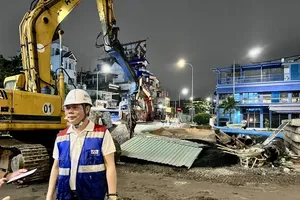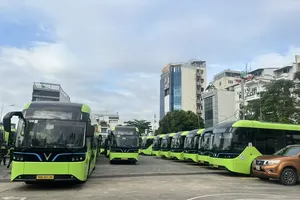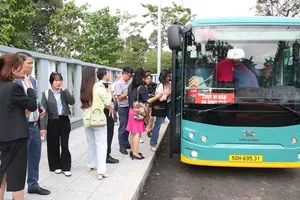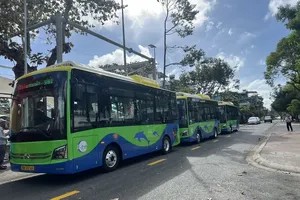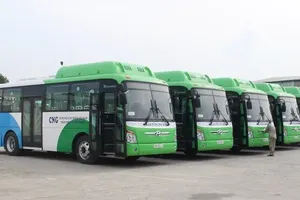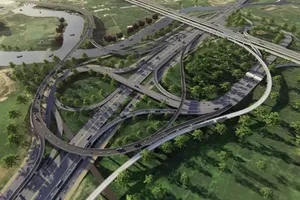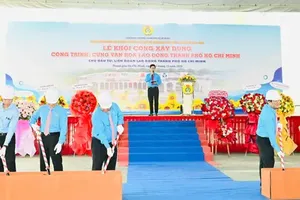 Number of workers from the Central Highlands returning to Ho Chi Minh City and the Southeast provinces tend to increase. (Photo: SGGP)
Number of workers from the Central Highlands returning to Ho Chi Minh City and the Southeast provinces tend to increase. (Photo: SGGP)
It was recorded that on the National Highway 14, the section through Dak R'Lap District, many groups of motorbikes with number plates from Dak Lak, Gia Lai, and Dak Nong provinces carrying luggage were returning to the Southern provinces and cities for work.
Hoang Van Cuong, a resident in Krong Bong District of Dak Lak Province, said that he had to suspend work in Binh Duong and return to his hometown in July when the pandemic developed complicatedly. However, after many months of unemployment, he could not find a suitable job in his hometown. After contacting his previous company, he decided to return to Binh Duong to continue to make money as the company pledged to ensure his position and salary. At the same time, workers would be vaccinated against Covid-19.
According to Mr. Hoang Viet Nam, Deputy Director of the Department of Labor, Invalids, and Social Affairs of Dak Nong Province, during the peak of the Covid-19 pandemic in Southern provinces and cities, about 20,000 workers returned to their localities to avoid the pandemic. Now when the pandemic is under control, many places have loosened social distancing, and companies have started to operate again, so many workers decide to return to the Southern provinces and cities to work.
On the same day, in Binh Phuoc and Dong Nai, many passenger buses carried workers from the Northern and Central provinces back for work. Besides passenger buses, many workers also moved by motorbikes in groups, passing quarantine checkpoints to return to Binh Duong, HCMC, and Dong Nai. The checking was fairly quick. Some checkpoints only checked when there were abnormal signs. The others only required people to present an ID card, a negative Covid-19 test result, or a Covid-19 vaccination certificate to pass through.
At the quarantine checkpoint of Tan Tuc bordering Long An Province and HCMC, people did not need to present rapid Covid-19 test results if they had had two doses of Covid-19 vaccines and papers proving that they work at this locality or return to HCMC. Meanwhile, the Cho Dem checkpoint on Trung Luong Expressway in HCMC still asked for rapid Covid-19 test results of people entering the city.
In the Mekong Delta, passing through checkpoints in Tien Giang Province remained difficult as people must present a negative rapid Covid-19 test result and quarantine following regulations. Meanwhile, people only needed to make medical declarations to pass checkpoints in Long An Province. In Ca Mau Province, authorities still controlled strictly and established separate channels for each group of people to carry out Covid-19 prevention measures at quarantine checkpoints.
In Vinh Long Province alone, the provincial People’s Committee decided to adopt pandemic prevention measures from midnight of October 15 until the end of October 31. Accordingly, people participating in construction and investment projects in the province must already get two doses of Covid-19 vaccines, have a valid negative Covid-19 test result, and announce to local authorities before their arrival.
Hoang Van Cuong, a resident in Krong Bong District of Dak Lak Province, said that he had to suspend work in Binh Duong and return to his hometown in July when the pandemic developed complicatedly. However, after many months of unemployment, he could not find a suitable job in his hometown. After contacting his previous company, he decided to return to Binh Duong to continue to make money as the company pledged to ensure his position and salary. At the same time, workers would be vaccinated against Covid-19.
According to Mr. Hoang Viet Nam, Deputy Director of the Department of Labor, Invalids, and Social Affairs of Dak Nong Province, during the peak of the Covid-19 pandemic in Southern provinces and cities, about 20,000 workers returned to their localities to avoid the pandemic. Now when the pandemic is under control, many places have loosened social distancing, and companies have started to operate again, so many workers decide to return to the Southern provinces and cities to work.
On the same day, in Binh Phuoc and Dong Nai, many passenger buses carried workers from the Northern and Central provinces back for work. Besides passenger buses, many workers also moved by motorbikes in groups, passing quarantine checkpoints to return to Binh Duong, HCMC, and Dong Nai. The checking was fairly quick. Some checkpoints only checked when there were abnormal signs. The others only required people to present an ID card, a negative Covid-19 test result, or a Covid-19 vaccination certificate to pass through.
At the quarantine checkpoint of Tan Tuc bordering Long An Province and HCMC, people did not need to present rapid Covid-19 test results if they had had two doses of Covid-19 vaccines and papers proving that they work at this locality or return to HCMC. Meanwhile, the Cho Dem checkpoint on Trung Luong Expressway in HCMC still asked for rapid Covid-19 test results of people entering the city.
In the Mekong Delta, passing through checkpoints in Tien Giang Province remained difficult as people must present a negative rapid Covid-19 test result and quarantine following regulations. Meanwhile, people only needed to make medical declarations to pass checkpoints in Long An Province. In Ca Mau Province, authorities still controlled strictly and established separate channels for each group of people to carry out Covid-19 prevention measures at quarantine checkpoints.
In Vinh Long Province alone, the provincial People’s Committee decided to adopt pandemic prevention measures from midnight of October 15 until the end of October 31. Accordingly, people participating in construction and investment projects in the province must already get two doses of Covid-19 vaccines, have a valid negative Covid-19 test result, and announce to local authorities before their arrival.






